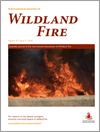International Journal of Wildland Fire
Volume 27
Number 5 2018
This review shows that research investigating emissions and haze evolved from smouldering peat fires is limited. Tropical peat fires exhibit higher emission factors for carbon gas species than boreal and temperate peat fires. Large uncertainties exist in both emission factors and understanding of combustion regimes.
Published statistical model projections of annual area burned over the south-eastern US to mid-21st century including county-level changes in climate and socioeconomic drivers of wildfires are leveraged to constrain probabilistic estimates of daily wildfire activity and emissions. These can help assess long-term air quality impacts and health risks from wildfires.
Where are buildings threatened and destroyed by wildfire in the conterminous US in relation to the wildland–urban interface (WUI) and to fire outreach communities, such as Firewise? The WUI encompassed most threatened and destroyed buildings (but with high inter-state variability) and Firewise communities were often established after fire.
For most species, leaf and litter bed differed in flammability; leaf thickness and litter bulk density being among the main drivers. Low flammability species, at both scales, should be favoured in the wildland–urban interface to mitigate damage on housing during wildfires.
We found that the mean tree size of stands was negatively associated with mid-storey vegetation cover and fire fuel hazard. Thus, the widespread removal of mature trees since European settlement may have contributed to a higher fuel hazard in forests. Our findings suggest that retaining mature trees could contribute to managing fire fuel hazard.
We investigated how the physical characteristics of woody fuels (> 0.6 cm diameter) affected their ignition and consumption. Ignition success was explained by woody fuel arrangement, suspension and decay status. Consumption was greater for fuels in advanced stages of decay, but suspension (inversely related) and arrangement (directly related) also affected the outcome.




